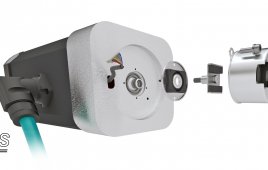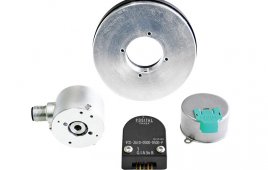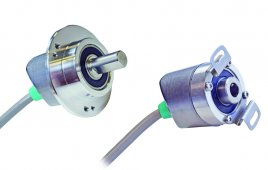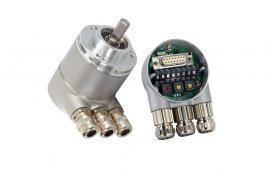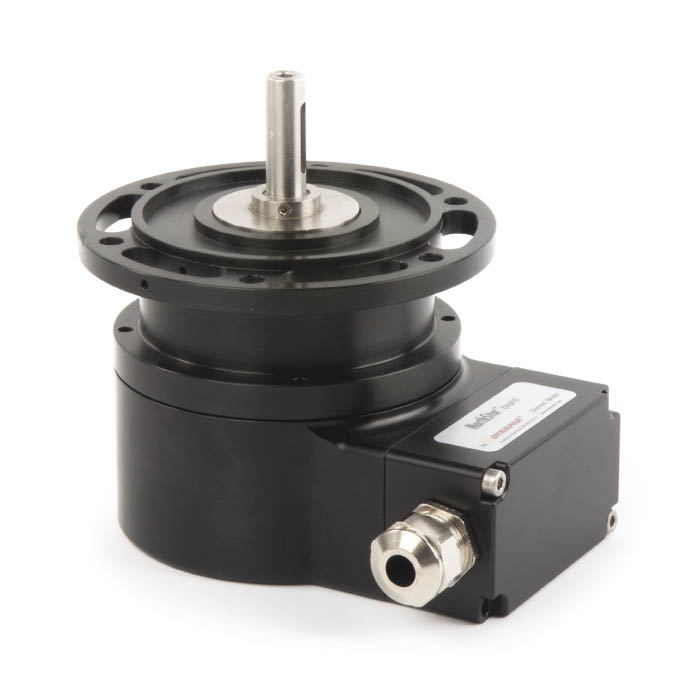
The HD35R encoder from Dynapar is rock solid with dual deep groove, oversized bearings and spec’d to 100 lb axial and 56 lbs radial loads. The manufacturer also uses a robust sealing method to make the encoder dust and moisture-tight with an IP67 enclosure rating.
Encoders serve an important purpose, so choosing the right one is an essential but complicated task. The device must work reliably, even in a tough environment. I’ve climbed a lot of turbines and can confidently say that wind applications are among the toughest around.
With that in mind, think about where you’ll find encoders in wind turbines. Starting at the hub and moving aft, you’ll spot encoders (incremental or absolute) on each pitch axis—particularly if electric motors are used to pitch blades. Moving further back, encoders are on yaw drives—usually incremental versions. At the nacelle’s downwind section, another incremental encoder sits on the back-end of the generator, typically outputting 3,072 pulses per revolution. Like all encoders in wind applications, generator feedback is mission critical—it cannot fail.
Generator encoders tend to experience stresses greater than other applications in the hub or nacelle. They meet more heat, shock, and vibration energy, and greater axial forces than any other encoder in the turbine. In short, generator encoders must be the toughest and most robust feedback devices available. As an encoder manufacturer, we provide feedback devices for tough applications. The company’s NorthStar line has been used in mill duty and oil and gas applications, and now the same technology is available for the wind market.
When I go up-tower, one of the first things I notice is that it’s hot—sometimes really hot. The generator is a large moving piece of electromechanical equipment that produces electricity along with a lot of heat. The generator encoder is directly coupled to the back-end of the generator, so it’s exposed to the high temperature. If the encoder isn’t built to withstand this heat, then plan on replacing it often. It will fail—probably at the most inconvenient time. The HD35R encoder from Dynapar is one solution to the heat problem. It has an extended temperature spec of 100°C to eliminate concerns of the device getting too hot. The encoder can also withstand temperatures down to -40°C so you don’t worry about it getting too cold either.
Another problem involves generators with floating end plates, a design that puts excessive force on the encoder’s bearings. A misaligned coupler can also introduce unwanted forces. Fixing an end plate or messing around with couplers in a dark, hot, tight nacelle is one way to alleviate these forces. Another is to simply use a tougher encoder.
Another common problem for generator encoders is carbon dust. The plenum on the back of the generator is positively pressurized to blow carbon dust away from its inner workings. The encoder is coupled directly on the back end so all this dust is blown on to the face of the feedback device. If carbon dust gets inside the encoder it can mean lights out, literally. How do we get around this? Simple: make the encoder dust tight.
Among the toughest forces for encoders to endure are shock and vibration. One of the surest ways to kill an encoder is to shock or vibrate it. Surprisingly, most encoders used on generators fall short in this area. Wind applications demand a rugged encoder, such as one spec’d to 400g of shock force and 3 kHz of vibration energy. The back end of your generator experiences more shock and vibration energy than you’d think. A tougher encoder lets you stop thinking about it. WPE
Filed Under: Encoders


